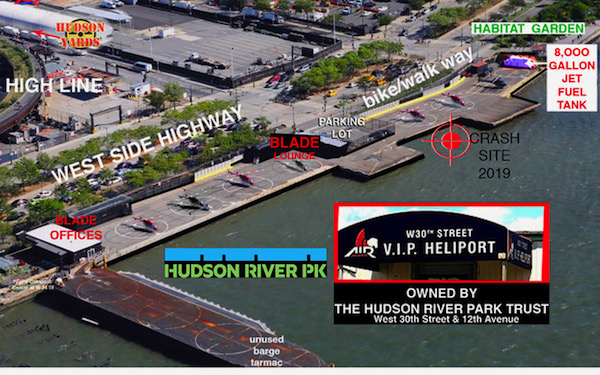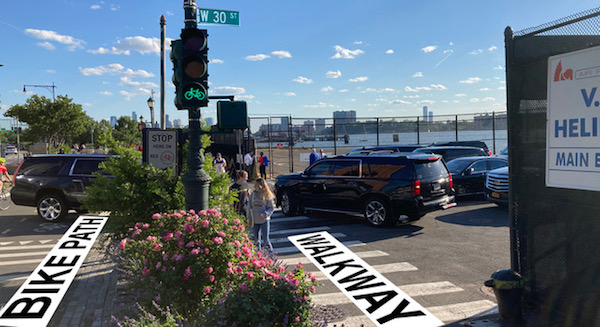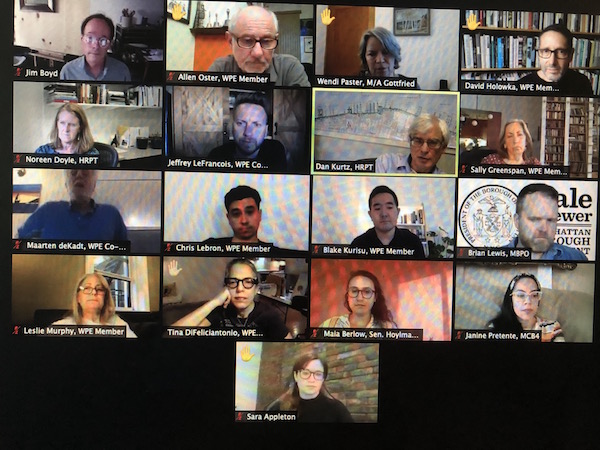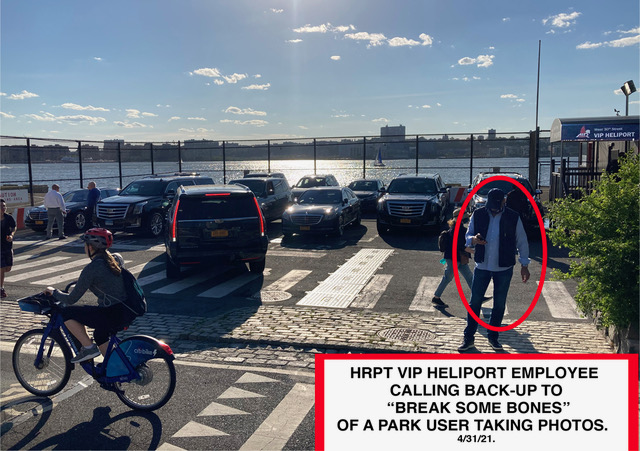BY WINNIE MCCROY | On the evening of Thursday, June 10, after a lengthy meeting, Community Board 4’s Waterfront, Parks & Environment (CB4’s WPE) Committee announced they would begin the process to shut down the West 30th Street Air Pegasus V.I.P. Heliport, which is owned by Hudson River Park Trust (HRPT, the Trust). The meeting can be viewed on CB4’s YouTube channel. Click here to do so.

“We want the heliport gone, full stop,” said CB4 Chair Lowell Kern, in an interview the following week, confirming that WPE’s decision is supported by the Board at large. (CB4’s full board meets next on July 28, and is expected to approve WPE’s letter.)
After presentations by HRPT CFO and Executive Vice President Dan Kurtz and incoming President and CEO Noreen Doyle (Madelyn Wills’ successor) as well as concerned community member Jim Boyd, CB4 members agreed that in addition to taking immediate safety measures, it was best to work toward stopping all commercial flights, closing down the Heliport and possibly constructing a helipad barge for medical-based emergencies requiring a helicopter.
“As always, we were glad to be invited to speak with Community Board 4 and to be given the opportunity to present the status and background of the Heliport to the members of the committee and the public,” a spokesperson for HRPT said after the meeting. “We will be working with our Board of Directors and the Heliport operator on the operational questions and concerns that were raised at the meeting and will continue to work with the community and our elected officials.”
This will not only throw a wrench into the works of W. 30th St. Heliport operator Air Pegasus, but it will also hamper the unfettered money-making abilities of aviation tech newcomer Blade, a sort of “Air-Uber” that connects those with deep pockets to private commuter aircraft to whisk them from the West Side heliport to JFK or LaGuardia, where a private jet can fly them to Miami, Nantucket, Aspen, and other locales.
History of the Heliport | Those unfamiliar with the Trust may not realize that there even is a commercial heliport at W. 30th St. It opened in 1956 under City ownership, was then transferred to the Port Authority and eventually landed under the ownership of the HRPT when it was formed in 1998–99. At that time, the New York City Helicopter Master Plan conducted under the framework of the Federal Aviation Administration identified a continuing need for a West Side heliport, but posited that it should phase out, reading, “The State’s agreement with Air Pegasus to operate the West 30th Street Heliport expires in 2001, and it is almost certain that the heliport will close then.”
Obviously, that certainty did not come to pass. The W. 30th St. Heliport remains as one of the City’s three commercial heliports, but unlike the ones at Wall St. and E. 34th St., it’s the only one located within a public park, about 20 feet from a heavily used pedestrian and bike path. It’s also the only one that operates 24 hours a day, with 11 helipads offering emergency and refueling purposes from their 8,000-gallon fuel tank.
In 2007, Friends of Hudson River Trust sued the Heliport’s operators to remove the facility. They reached a settlement in 2008 that the Heliport would be relocated or closed by 2014. But in 2013, a state bill allowed the Heliport to remain in perpetuity.
In March 2018, when a “doors off” sightseeing tour crash killed all five passengers, such tourist flights were banned. A crash near the W. 30th St. Heliport in May 2019 again raised safety concerns, leading Air Pegasus to cease all tourism-based flights.
HRPT’s Kurtz explained that the Heliport, now leased by Air Pegasus on a monthly basis, later agreed to relocate the Heliport west of the HRPT bulkhead by 2014. One idea “floated” was to relocate the Heliport to a barge 1,000 feet off the Park’s shore. Obviously, neither relocation happened, but the operators faced no penalties.
“The 2008 settlement allowed the Heliport to be forced closed by 2014 if it was not relocated to west of the bulkhead,” said Kurtz. “But there was more Heliport use and it has raised the ire of many in the area, including several in this call.”
Kurtz explained prior gubernatorial administrations objected to the closure, and allowed the Heliport to continue operating east of the bulkhead until the “relocation” area was identified, i.e., the continuation of the status quo.”
Kutz acknowledged mission drift, noting, “I know this site is inconsistent with the intent of the act, which mandated they move the heliport to a location west of the bulkhead on the barges, thereby transforming the existing Heliport site back into park space.” That was, and remains, said Kurtz, “the Trust’s objective. We have placed aside funds for redesign plans of 29th-44th Street, which includes shifting the Heliport.”
Funds are part of the equation, as Kurtz noted the Heliport brought in $1.7M in annual revenue to the HRPT, prior to Covid. WPE member Brad Pascarella said although people want to get rid of the Heliport, that money came in handy toward keeping the Park clean.
“The Heliport remains there out of inertia,” countered WPE member David Holowka, adding, “While $1.7M is not chicken feed, we sure wouldn’t consider introducing another Heliport to make that money.”
When pressed by Holowka, Kurtz seemed to agree that the planned 2013 relocation simply never happened, but said that the Trust did have the ability to end Air Pegasus’s lease, saying, “It’s month-to-month, so if we were directed, we could terminate it.”
“Directed?” asked WPE member Sara Appleton.
“Members of the Trust’s Board are appointed by the mayor, governor, and borough president,” explained Kurtz. “If they wish it to be closed, they would so direct it.”
Appleton noted the Heliport revenue accounts for a mere 10 percent of HRPT’s annual operating budget of $27M. When asked, Doyle assured WPE members that HRPT would still be able to capture that revenue if the Heliport were relocated to a barge over the water, but Kurtz suggested that it would be fewer helipads in that location.

Environmental and Safety Concerns | In addition to the obvious safety hazards, helicopters are notorious polluters. Boyd countered Pascarella’s comment about Heliport funds helping to clean up the park by noting that, as opposed to automobiles 22 lbs. of air pollution per hour, “These helicopters are crop-dusting the park with a 950 lbs. of toxins per hour, per helicopter. And it is only being used by those with extreme wealth—as you mentioned, there are no tourist flights. We are enabling this privilege for an extremely small group of global wealth leaders at intense risk to our safety.”
He further pointed to the additional dangers of having the Heliport located so close to the bikeway in the middle of a public park, adjacent to both the West Side Highway and the Habitat Garden. Boyd also noted the 8,000-gallon tank of fuel located on the Heliport, which brings its own set of dangers.
Boyd said he’d heard of three women suing after being blown off their bicycles. He also noted the general toxic miasma surrounding the Heliport, and the many letters CB4 had sent the operator throughout the years, demanding they shut it down.
“All you have to do is walk by to see how insane it is; it’s just not appropriate to have this in a park,” said Boyd. “If a tarmac is needed for emergency medical flights, the barge perpendicular to the Hudson River Park is unused.”
On a personal note, Boyd recounted his recent Memorial Day photo-gathering visit to the Heliport, where he said employees of Air Pegasus threatened to “break some bones” if Boyd continued to hang around taking pictures of the operation, with him adding, They threatened to beat me up, and I believe he would have.” Boyd said he appealed to the employees as a fellow member of the working class, but was rebuffed. He understood that chauffeurs and other employees depended on the jobs created by the Trust, and would therefore defend their livelihood.
His arguments gained momentum after WPE member Allen Oster shared his own observances about the Heliport. Oster said he tracked comings and goings at the Heliport from March–October 2019 and in those 72 instances found that more than half of the helicopters spent up to 25 minutes idling, without passengers. A similar situation was happening with chauffeured vehicles.
“In my observations, 38 percent of the landings were parallel to the walkway, and oftentimes their approaches washed water onto the walkway and created extensive noise to people sitting near there,” said Oster. “And as Jim pointed out, a dozen SUVs and for-hire cars are idling there, keeping cool. The 2019 photos didn’t show any flag person, which HRPT insisted they have there. Why is there even a need for a parking lot inside the Park when some sort of facility could be put up across the highway? Then when the helicopters come in, the car can be called to do their pickup and leave.”
During the public comments section, Melissa Elstein of Stop the Chop NY/NJ noted that in addition to intense air pollution from jet fuel, helicopters cause noise pollution when flying over neighborhoods and other parks, water pollution due to de-icing chemicals, avgas, ozone, and toxic lead. She pointed to Europe’s recent decision to prohibit domestic flights for trips that could take under 2.5 hours by train, and urged HRPT to look more broadly at the true environmental impact of helicopters.
“It’s awesome that HRPT is working on educating children and adults on plastic pollution and composting, but whether it’s in the Park or on empty barges in the river, these helicopters will still be contributing to water and air pollution around New York and New Jersey,” said Elstein. “I understand many companies are working on electric helicopters, and we can revisit this when they’re being widely used, but right now, why should we be allowing non-essential fossil fuel commuter helicopters here?”
Unsafe, A Terrorist Target? | Multiple attendees pointed to various unsafe elements around the W. 30th St. Heliport. As noted earlier, the constant movement of SUVs and for-hire vehicles across the bike/pedestrian path into the Heliport parking lot have led to many near mishaps.
“Allen’s observations caused us to force [Air Pegasus] to get a traffic manager,” said Kurtz. “The purpose of the lot is not to have cars sitting there for an hour waiting for the next helicopter to arrive. We were not aware they were waiting there so long. They stopped having a traffic manager there during Covid because they said there weren’t many customers.”
Oster said with the popularity of motorized bicycles and mini motorcycles on the path, it would be hard for someone to stop on that blind corner, even if the traffic manager resumed flagging operations.
WPE member Tina DiFeliciantonio also noted the inherent dangers in the location of the 8,000-gallon fuel tank near the helipads, saying, “There must be some legislation that dictates what is or is not a safety hazard. I am wondering if anybody has done a study in terms of the placement of that fuel tank in relation to the helicopters—is it safe there, or is it prime picking for some kind of terrorist attack?”
Boyd interjected that he believed the whole facility was extremely vulnerable to attack, saying, “Anyone can just walk or bike or even boat right up to that gas tank, which is within feet of operating helicopters. Also, there is no passenger review and no security, they just get right out of the SUV and into the helicopter.”
He said the 2007 settlement included a fairly detailed protocol about how flights should approach the Heliport and how long they should idle. Boyd also believes that helicopters should not refuel while idling. He pointed to a charred No Smoking sign on the gate as the only indication something flammable was located nearby.
DiFeliciantonio suggested that the WPE review Heliport protocol, and get the EPA to inspect the tons of exhaust being produced. She also took issue with the No Smoking signage.
“To allow that sign to decay like that next to a fuel tank is just a disgrace,” said DiFeliciantonio. “Something needs to be done immediately about that… to bring in the agencies in terms of compliance.”
Community members also chimed in about the Heliports’ vulnerability to terrorist attack, referencing the Halloween 2017 attack by an ISIS-inspired fanatic that mowed down eight people on the Hudson River bike path, which DOT owns but HRPT manages.
“A good friend lost her son in that terrorist attack in the bike lane,” said community member Carla Fine. “It’s shocking for me to walk by a helicopter pad where there are no traffic managers, where nobody is out there. Somebody is going to get hurt or killed, and who will be financially, legally, and morally responsible? It’s just so shocking you’re willing to give up lives to have, as Jim pointed out, people be able to fly to the Hamptons for $900 and throw in an extra $100 for their dog. It’s really disgusting.”
WPE members decided to draft a series of letters to begin the process of first implementing safety procedures, then closing down the Heliport. WPE member Chris LeBron offered to assist WPE Co-Chair Maarten de Kadt in drafting these letters, but de Kadt said that with mostly anecdotal evidence, he’d first like to see a comprehensive study done on pedestrian safety in that area.

A discussion ensued about which agencies managed what resources, with Doyle noting that the traffic lights are run by the City DOT, but the bike lane by the State DOT, saying, “not everything you’ve named is in our power to control.”
“I’ve heard enough complaints about that bikeway and safety, notwithstanding terrorist attacks, but we have no analysis and no recommendations for safety,” said de Kadt. Because of the multiple agencies involved, de Kadt warned against a “bifurcated analysis of what’s needed, with each agency only looking at their own pebbles and rocks,” insisting that a comprehensive study be funded.
In an interview before the Zoom meeting, Boyd told CCN that he believes the age of private air transportation is over and that if HRPT were truly a steward of the environment, they shouldn’t be making money from the most polluting form of travel.
“But Blade CEO [Robert] Weisenthal went public earlier this year via an $850M SPAC (special purpose acquisition company), including the heavy backing of Barry Diller who just built the Little Island that HRPT is in love with, and he has close ties to the Trust,” said Boyd, insinuating a bit of quid pro quo that could make it hard for HRPT to say ”no ‘ to these monied interests. “The paradox is they’ve invested in a helicopter company that will be buzzing Little Island continuously with flights made exclusively for global wealth, the 0.1 percent of transient New Yorkers.”
Until recently, the Chair of the HRPT was Diana Taylor, millionaire Mike Bloomberg’s partner, who owns several helicopters. In fall of 2020, Gov. Andrew Cuomo appointed Trust board member Basil Seggos—his advisor on environmental policy and issues—as Chair of HRPT. It was hoped Seggos would help with perceived lack of transparency, which led to questions of whether the Trust was being run by the staff or the monied Board, appointed by the State’s top elected officials.
“It feels like the Park and the High Line were given the green light as long as they’re allowed to continue to use this prime real estate,” said Boyd.
Said community member David Koch, who noted he did not sit on any boards or committees, “The Park means so much to my life. I go there all the time, but increasingly feel that helicopter traffic is bringing me to the brink of a nervous breakdown. If you cannot recreate in peace, there’s no point in going to the park. It’s interesting to find that Barry Diller is an investor in Blade when his Little Island is supposed to be a concert space. How can you sit and enjoy a show when you are constantly facing Apocalypse Now moments?”
Elite Business in a Public Park | In his original presentation, Boyd took issue with the small percentage of wealthy individuals that benefited from the W. 30th Heliport, as opposed to the vast majority of New Yorkers left to deal with the byproducts of having this service located in a public waterfront park.

“Their financial influence on the Trust is, I feel, very strong, and they’re not going to just walk away,” said Boyd. “Contrary to what the CEO said, their flights increased 80 percent before Covid, and they did very well during Covid shuttling people in from the Hamptons for a couple hours of work.”
Boyd believes even electric helicopters will cause pollution issues, and will only serve to expand a group of privileged commuters, noting that the millions of daily subway riders won’t now be taking helicopters to work—it will still be for wealthy commuters from the Hamptons or Millbrook.
“It’s something I think the Trust needs to cast a gimlet eye on, because I don’t think this is really going to happen,” said Boyd, adding, “Parks are not used by this class of people. They fly off to their private estates.”
HRPT’s Kurtz said that as he understood it, the City and State kept the Heliport open due to their own desire that it continue operating, and with no notification to the Trust. He said he didn’t know why the Heliport had never been moved west of the bulkhead, as the earlier legislation mandated, and admitted that “not too many people on the West Side would be enthusiastic about having it relocated in front of their facility.”
Back in 2013, Assembly Member Richard Gottfried helped introduce legislation that gave Air Pegasus the option of moving the heliport to a barge 1,000 feet off the park. Now, almost a decade later, it remains where it always was.
Said Gottfried’s Chief of Staff Wendi Paster, “Everyone would have preferred to have legislation that got rid of the heliport rather than move it, but it was a non-starter. We wanted to move it to the barge because the City and State were so insistent it remain for commercial emergency use. That said, Gottfried would be happy to draft legislation that didn’t just move it within the Park, but gets rid of it completely. Whether that’s DOA, I don’t know.”
Finding it hard to defend the commercial aspect of the Heliport, WPE members like Holowka spoke against it, despite arguments by Katz that its operating costs were covered by a private company, and that charter flights by Blade were more efficient in a sense because rather than transporting one or two people, the helicopter would leave completely full.
And, in a separate interview, Boyd told CCN that while helicopter noise and environmental pollution were being downplayed as quality-of-life issues that could be dealt with at some later date, regular New Yorkers’ lives were spent propping up the lifestyles of the wealthy elites.
“When the pandemic hit, most of us were left on the pier watching the tide rise while the wealthy flew off to safety,” said Boyd. “Meanwhile, they made insane profits on all their investments including Blade, while the rest of us were suffering. It’s obscene.”
A Real Chopper Stopper | At the end of his presentation to the WPE Committee, Boyd simply noted that it was unethical to allow the Trust to continue making a substantial revenue off the Heliport while neighbors suffered. He begrudgingly allowed for a medical and emergency heliport to be constructed on a barge in the river. Then he begged for leadership from, of all places, the HRPT.
“If the Trust comes out with the clarion call that they are closing the Heliport, and say it loud enough to be heard in Albany, it could be closed,” said Boyd. “What can Cuomo do if all of you and the public say, ‘We’re closing this, we don’t see any use by the public at large for this facility.’ Do you think the Trust could muster that kind of stewardship?”
And the WPE Committee agreed. Pascarella compared it to not preparing for cars during the end of the horse and buggy era, and echoed DiFeliciantonio’s calls to involve environmental agencies. LeBron called Oster’s observations “spot-on,” saying they could no longer back away from the truth. WPE member and City Council candidate Leslie Boghosian-Murphy noted that CB4 had been fighting to close the Heliport for a very long time, and asked HRPT’s Doyle if there was something they could do to “move the needle” and get it done.
WPE Co-Chair Jeffrey LeFrancois interrupted to remind members that the HRPT Board directs staff on what to do, saying, “Our job is to tell the Governor and the Mayor what we want to happen, and they’ll say what to do.”
He noted that their immediate goals were to move and relocate the Heliport, fuel tank safety, end on-site parking, and bring in various environmental groups. LeFrancois mused on what they could do to undercut the City and State’s argument that the Heliport was an economic need.
Still, his WPE Co-Chair de Kadt threw shade over his interjection, saying, “But wouldn’t it be interesting to have Noreen answer?”
Doyle did answer, saying that in addition to the legitimate operating issues they were trying to address, there was the rationale for having a Heliport in the Park. Also, she referenced the inequity that those New Yorkers on the East Side had expressed to her regarding not having any waterfront park at all.
WPE Public Member Sally Greenspan echoed Boghosian-Murphy’s point about getting this issue to the next step, and Senator Brad Hoylman’s Deputy Chief of Staff offered him to write or amend legislation, all the while searching for a way to get the Heliport moved “outside of writing a bill that the State may or may not pass,” especially as this year’s legislative session ended last Friday.
So LeFrancois stepped up with his list of notes and proposed a series of letters to begin “our plan of attack.” De Kadt suggested a two-part letter, the first addressing immediate safety fixes like the traffic lights, reduction of idling vehicles, and securing the fuel tank, to be enacted within the next four months.
“The second part of the letter is more difficult, about moving the helicopter facility itself, which we’ve been talking about for years,” said de Kadt. “It has to do with constraints on the HRPT, the law, and our relationships with the Governor, Mayor and other people who can say, ‘Move it immediately.’ ”
As Holowka noted, “Noreen and Dan seem to be saying it’s in the hands of the Mayor,” with LeFrancois echoing that HRPT’s “Board of Directors could say, ‘Close it.’ So, I think immediate recommendations could be made to the Trust to talk to their tenant Air Pegasus, but eventually asking them to get rid of it.”
Numerous WPE Members agreed to pursue both tacks, having Hoylman and Gottfried draft legislation closing the Heliport for all but emergency use, with HRPT enforcing any powers they have in their lease with Air Pegasus to enact immediate, short-term fixes.
Finally, LeFrancois suggested three letters: one to elected officials asking them to write the legislation; one to the Mayor and Governor asking them to permanently relocate the Heliport; and a third letter to HRPT about addressing safety issues.
Three ended up being the magic number, agreed WPE members. In time, they mused, there will be no more commercial helicopter flights from the W. 30th St. Heliport.
CCN followed up with CB4 Chair Lowell Kern to confirm that this committee decision was supported by the Board at large. He leaned into that decision fully, saying the Board had contacted Hoylman about drafting legislation that amends the Hudson River Park Act currently permitting the Heliport, adding, “Although we didn’t get it done this legislative session, we’re hopeful it gets picked up by elected representatives next session.”
“In the meantime, until the legislation is passed that will eliminate the Heliport, we need some safety fixes,” said Kern. “It’s not just that we want it gone eventually—we want it GONE. A commercial heliport doesn’t belong in the middle of the Hudson River Park.”
READER COMMENTS (The “Comments” option on our website is out of order. Please email your Reader Comments to our editor, via scott@chelseacommunitynews.com).
“Hi there, thanks for your excellent reporting on the CB4 Zoom meeting regarding the heliport / HRPT issue. The article is outstanding. Thanks for using one of our quotes, too! Stop the Chop NY/NJ is an all-volunteer led nonprofit organization with a mission to ban the nonessential helicopter traffic that is negatively affecting so many in the NY metropolitan area. Please join our movement by signing our petition, signing up for the newsletter, donating, and volunteering with us! Links are on our website as well as relevant information such as introduced legislation: www.stopthechopnynj.org.
Melissa Elstein, Board Member – Stop the Chop NY/NJ
Chelsea Community News is made possible with the help of our awesome advertisers, and the support of our readers. If you like what you see, please consider taking part in our GoFundMe campaign (click here). To make a direct donation, give feedback, or send a Letter to the Editor, email scott@chelseacommunitynews.com.


Pingback: Chorus of Critics Call for Closure of Hudson River Park’s Heliport for the Privileged – Chelsea Community News